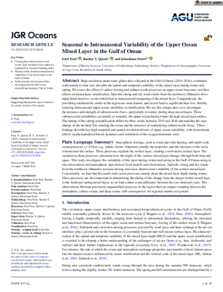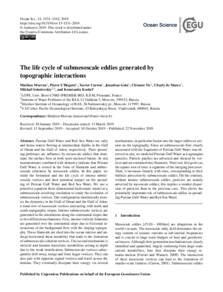Document
Seasonal to intraseasonal variability of the upper ocean mixed layer in the Gulf of Oman.
Identifier
DOI: 10.1029/2021JC018045
Source
Journal of Geophysical Research: Oceans. v. 127, 3, e2021JC018045
Contributors
Queste, Bastien Y., Author
Swart, Sebastiaan., Author
Country
United States.
City
Hoboken
Publisher
John Wiley and Sons Inc.
Gregorian
2022-03-01
Language
English
Subject
English abstract
High-resolution underwater glider data collected in the Gulf of Oman (2015–2016), combined with reanalysis data sets, describe the spatial and temporal variability of the mixed layer during winter and spring. We assess the effect of surface forcing and submesoscale processes on upper ocean buoyancy and their effects on mixed layer stratification. Episodic strong and dry wind events from the northwest (Shamals) drive rapid latent heat loss events which lead to intraseasonal deepening of the mixed layer. Comparatively, the prevailing southeasterly winds in the region are more humid, and do not lead to significant heat loss, thereby reducing intraseasonal upper ocean variability in stratification. We use this unique data set to investigate the presence and strength of submesoscale flows, particularly in winter, during deep mixed layers. These submesoscale instabilities act mainly to restratify the upper ocean during winter through mixed layer eddies. The timing of the spring restratification differs by three weeks between 2015 and 2016 and matches the sign change of the net heat flux entering the ocean and the presence of restratifying submesoscale fluxes. These findings describe key high temporal and spatial resolution drivers of upper ocean variability, with downstream effects on phytoplankton bloom dynamics and ventilation of the oxygen minimum zone.
ISSN
2169-9275
Category
Journal articles


